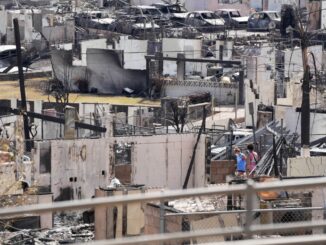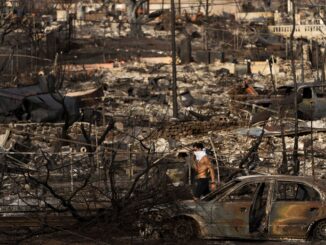
The devastating fires on Maui in August, 2023 were horrific. Hundreds of homes and businesses lost, dozens of people killed, and an entire town, Lahaina, with a rich history, obliterated. It will likely be a decade or more before the community recovers its vitality.
There is evidence that energized power lines contributed to the fire, particularly when poles snapped or trees fell on lines. A lot of lawyers will bill a lot of hours before any liability for the fire damage to homes and businesses affects the utility. Maui Electric Company is a subsidiary of Hawaiian Electric Industries (which also owns the utilities serving Oahu and the Big Island of Hawaii, plus American Savings Bank).
One near-term side-effect of these fires will be higher electricity bills for the homes and businesses that were not destroyed. And this will happen fairly quickly, due to the operation of Hawaii’s electricity regulation framework, which includes a “decoupling” mechanism to separate the utility earnings from its sales volumes and a “major project interim recovery” mechanism to pay for new utility investments.
An immediate effect of the fires will be lower electricity consumption. Many homes and businesses are gone, and tourism is sure to be lower for several years.
The Federal Emergency Management Agency (FEMA) has reported the loss of more than 2,200 buildings. Maui Electric has only about 75,000 customers total, so this is about 3% of the customers of the utility. Some of the displaced residents will remain on-island, and move in with friends, relatives, or vacant vacation properties, and continue using electricity. Others will leave the island, some to the mainland, others to Honolulu or the other islands. The decline in homes and businesses will immediately reduce electricity sales.
In addition, more than 12,000 customers were without electricity for days while the main power lines to the areas in West Maui beyond Lahaina were rebuilt. That is one-sixth of Maui Electric customers. A week after the fire, Maui Electric reports that 90% of customers have power – meaning 10% do not. And customers in West Maui were warned to expect outages of up to several weeks. Tourism to the affected area of the island will be slow to return, so electricity usage will remain suppressed for months or even years to come. Because the island economy is dependent on tourism, local income will also be lower as a result of the fires.
This element of decoupling mechanisms after a fire or natural disaster has affected other utility systems. In California, where public safety power shutoffs and other outages have occurred due to the risk of wildfires, one criticism of the decoupling mechanism is that it makes the utility shareholders indifferent to the quality of service to customers. In a major storm, wildfire, or other system disturbance, shareholder earnings are protected, and the incentive for the utility to restore service quickly to “get the cash register going” is reduced.
Under the Hawaii Revenue Balancing Account (RBA) mechanism, the utility return, taxes, and other costs that are built into rates are assured of recovery regardless of sales volumes. A loss of sales therefore means an increase in prices to those still receiving power. The mechanism is designed to ensure that the utility will be unopposed to investments in energy efficiency and renewable energy. A side-effect is that the utility is immune to earnings impacts of a major disaster that reduces sales.
In addition, Maui Electric will need to completely rebuild a portion of its distribution system as Lahaina is rebuilt. New distribution plant is more expensive than equipment installed decades ago, and this will also be added to the utility rate base, on which a return is calculated. A “major project interim recovery” adjustment is a part of Maui rates, to recover the cost of major new investments in a timely fashion. That may apply to the recover costs from this fire, or perhaps a different mechanism will be used. In general, the costs to recover from utility system damage associated with extraordinary weather events outside of the control of the utility is allowed into rate base and paid for by electricity consumers.
The only devastation of this magnitude in recent Hawaii history was the complete destruction of the electricity distribution system in Kauai following hurricane Iniki in 1992. Thousands of homes were damaged, hundreds were destroyed, and the bulk of the electric power grid was out of service for six weeks. That restoration took several months for the power system, and many years for the buildings. Iniki was a far more severe impact on the power system, as the impact was island-wide (but not nearly as devastating as the Maui fires in terms of loss of life or cultural history in Lahaina.)
After that hurricane, Kauai Electric (KE) filed a major rate increase to recover the high costs of the system rebuild. After that expense, Kauai had the highest electricity prices of the four major island systems. In 2002, the system was sold to Kauai Island Electric Cooperative (KIUC), a community-owned power system operator.
In 2018, a major lava flow on the Big Island of Hawaii damaged the Puna Geothermal Venture (PGV) geothermal power plant, forcing it out of service for two years. The lava flow also destroyed about 700 houses, but most people had time to remove their belongings as the flow was gradual. However, the ratepayer impact was very different. PGV is independently owned, these costs are not in the utility rate base, but flow through as a purchased power expense. While Big Island ratepayers DID have to pay the cost for replacement power, from expensive oil-fired generators, the costs of PGV itself were NOT paid by the utility, and NOT passed through to ratepayers until it was again actually producing power. This is one of many advantages to having power plants owned independently (there are also some disadvantages). I wrote a paper on this topic in 1982 for the California Energy Commission, entitled A Ratepayer Perspective on Avoided Cost Pricing.
It is not yet known if the Maui Electric Company will bear some responsibility for these fires. This has been a major issue in California, and a contributing factor to the bankruptcy of Pacific Gas and Electric Company in 2018. The current FEMA damage estimate, as of August 20, 2023, is in excess of $5 billion. There are news reports that some of the earliest fires were associated with electric distribution lines. If the utility does bear some responsibility, the multi-billion dollar damage will surely dwarf the financial capacity of the utility, which has only about $400 million/year in gross revenues.
To summarize:
- Sales are down; this results in higher rates for remaining customers through the Hawaii decoupling mechanism;
- The costs to rebuild will be significant; that will further increase rates; this results in higher costs for remaining customers through the Hawaii major projects capital recovery framework;
- The Maui economy will be damaged for years to come; the ability of the remaining customers to absorb higher costs will be impaired by this;
- The Hawaii PUC will face a severe challenge in meeting its obligation to ensure adequate service at fair rates;
- If the utility is held liable for a significant portion of the fire damage, these liabilities will quickly overwhelm the financial capacity of the company.
There is one potential bright spot in the future: a newly rebuilt distribution system will be more modern, more reliable, and more efficient. In the long-run, that will pay benefits for the future residents and businesses that rebuild in the Lahaina area. Three decades after Hurricane Iniki, Kauai today has the lowest rates in Hawaii. This is due to a combination of a high reliance on lower-cost solar energy and other renewable resources, a modernized distribution system, and the advantages of the cooperative form of community ownership of the power system.



